Privatization in Saudi Arabia
VerifiedAdded on 2019/10/18
|22
|6594
|256
Report
AI Summary
This report provides a comprehensive analysis of privatization in Saudi Arabia, focusing on its necessity given the country's heavy reliance on oil revenue. It examines the background of privatization, exploring global experiences in countries like India, the USA, and the UK. The report details various privatization methods, including IPOs, public auctions, and public tenders. It then delves into the challenges facing Saudi Arabia in implementing privatization, such as capital market issues, employee resistance, debt problems, transparency concerns, and potential monopolies. The report concludes by offering solutions and recommendations for a successful privatization framework, emphasizing the importance of administrative responsibility, legal considerations, regulation, employment conditions, and post-privatization control. The report highlights the need for a balanced approach that considers economic growth alongside social and employment implications.
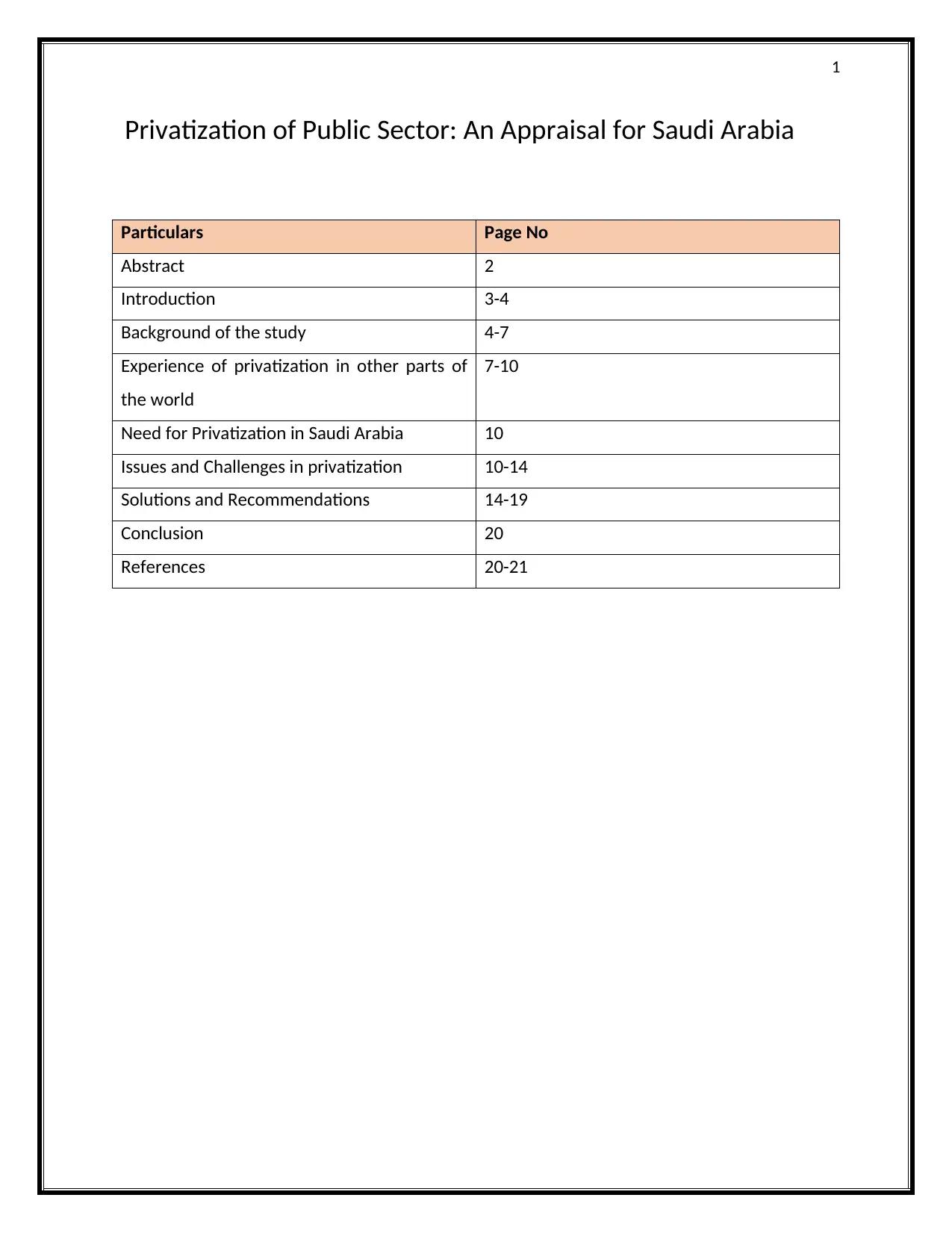
1
Privatization of Public Sector: An Appraisal for Saudi Arabia
Particulars Page No
Abstract 2
Introduction 3-4
Background of the study 4-7
Experience of privatization in other parts of
the world
7-10
Need for Privatization in Saudi Arabia 10
Issues and Challenges in privatization 10-14
Solutions and Recommendations 14-19
Conclusion 20
References 20-21
Privatization of Public Sector: An Appraisal for Saudi Arabia
Particulars Page No
Abstract 2
Introduction 3-4
Background of the study 4-7
Experience of privatization in other parts of
the world
7-10
Need for Privatization in Saudi Arabia 10
Issues and Challenges in privatization 10-14
Solutions and Recommendations 14-19
Conclusion 20
References 20-21
Paraphrase This Document
Need a fresh take? Get an instant paraphrase of this document with our AI Paraphraser
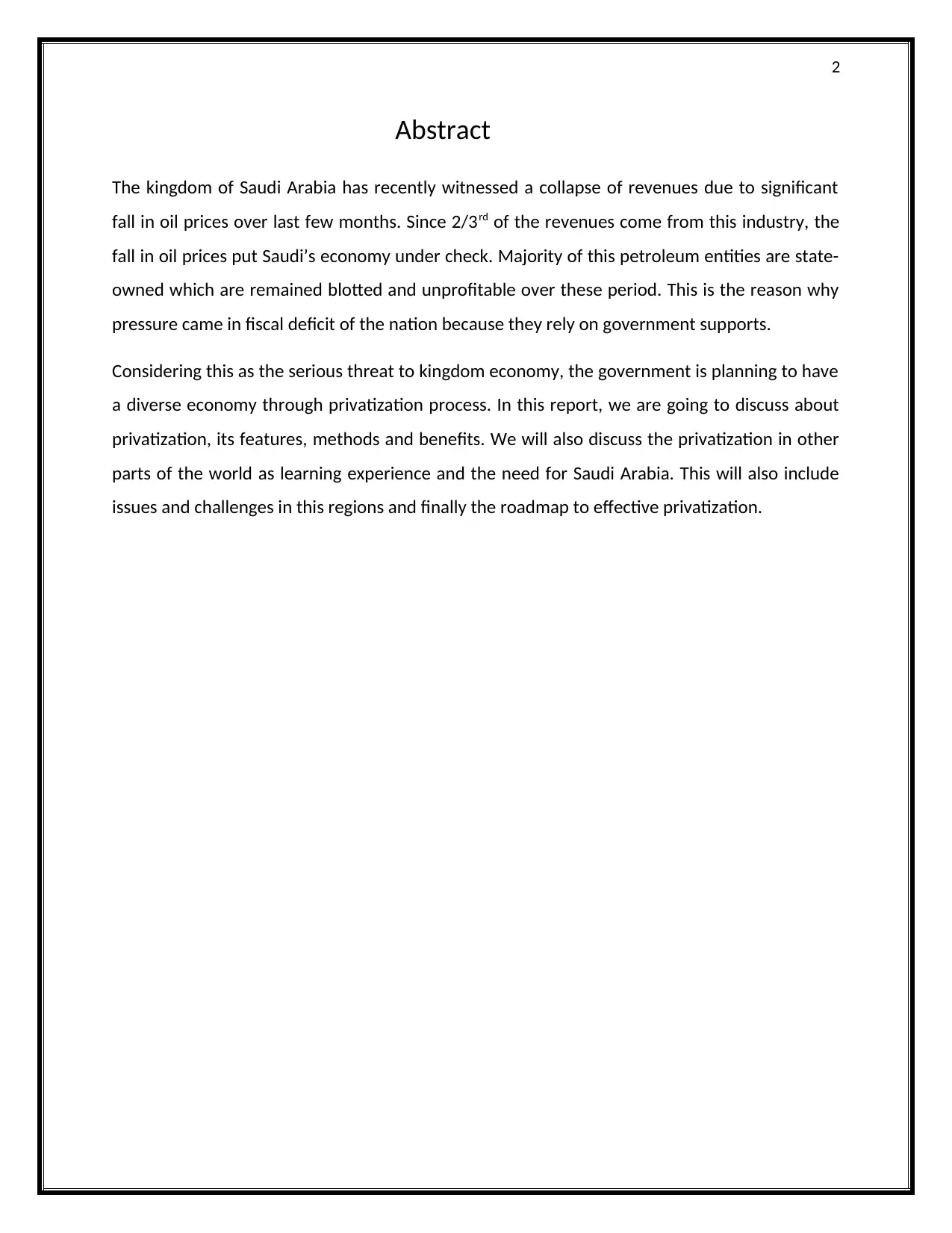
2
Abstract
The kingdom of Saudi Arabia has recently witnessed a collapse of revenues due to significant
fall in oil prices over last few months. Since 2/3rd of the revenues come from this industry, the
fall in oil prices put Saudi’s economy under check. Majority of this petroleum entities are state-
owned which are remained blotted and unprofitable over these period. This is the reason why
pressure came in fiscal deficit of the nation because they rely on government supports.
Considering this as the serious threat to kingdom economy, the government is planning to have
a diverse economy through privatization process. In this report, we are going to discuss about
privatization, its features, methods and benefits. We will also discuss the privatization in other
parts of the world as learning experience and the need for Saudi Arabia. This will also include
issues and challenges in this regions and finally the roadmap to effective privatization.
Abstract
The kingdom of Saudi Arabia has recently witnessed a collapse of revenues due to significant
fall in oil prices over last few months. Since 2/3rd of the revenues come from this industry, the
fall in oil prices put Saudi’s economy under check. Majority of this petroleum entities are state-
owned which are remained blotted and unprofitable over these period. This is the reason why
pressure came in fiscal deficit of the nation because they rely on government supports.
Considering this as the serious threat to kingdom economy, the government is planning to have
a diverse economy through privatization process. In this report, we are going to discuss about
privatization, its features, methods and benefits. We will also discuss the privatization in other
parts of the world as learning experience and the need for Saudi Arabia. This will also include
issues and challenges in this regions and finally the roadmap to effective privatization.
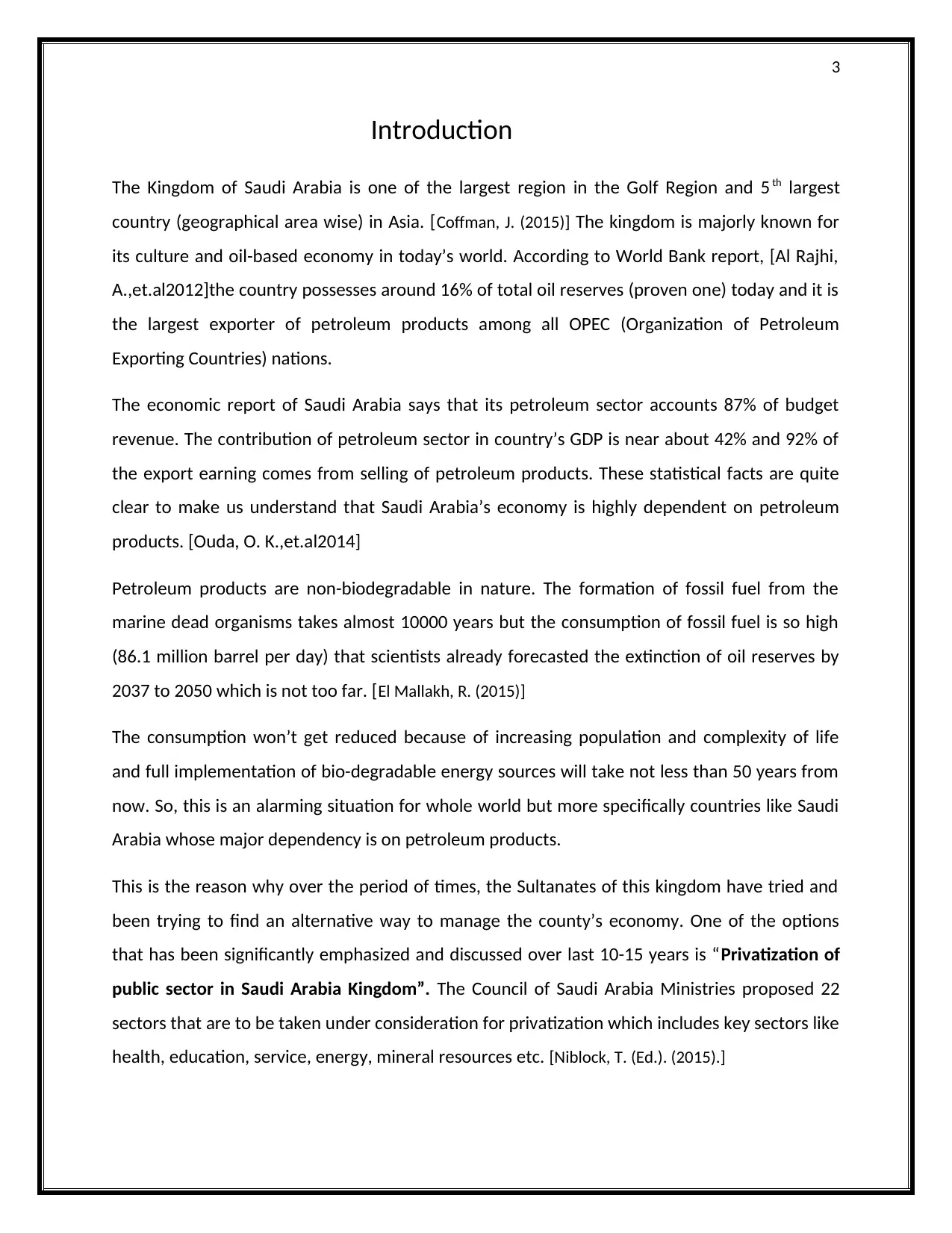
3
Introduction
The Kingdom of Saudi Arabia is one of the largest region in the Golf Region and 5 th largest
country (geographical area wise) in Asia. [Coffman, J. (2015)] The kingdom is majorly known for
its culture and oil-based economy in today’s world. According to World Bank report, [Al Rajhi,
A.,et.al2012]the country possesses around 16% of total oil reserves (proven one) today and it is
the largest exporter of petroleum products among all OPEC (Organization of Petroleum
Exporting Countries) nations.
The economic report of Saudi Arabia says that its petroleum sector accounts 87% of budget
revenue. The contribution of petroleum sector in country’s GDP is near about 42% and 92% of
the export earning comes from selling of petroleum products. These statistical facts are quite
clear to make us understand that Saudi Arabia’s economy is highly dependent on petroleum
products. [Ouda, O. K.,et.al2014]
Petroleum products are non-biodegradable in nature. The formation of fossil fuel from the
marine dead organisms takes almost 10000 years but the consumption of fossil fuel is so high
(86.1 million barrel per day) that scientists already forecasted the extinction of oil reserves by
2037 to 2050 which is not too far. [El Mallakh, R. (2015)]
The consumption won’t get reduced because of increasing population and complexity of life
and full implementation of bio-degradable energy sources will take not less than 50 years from
now. So, this is an alarming situation for whole world but more specifically countries like Saudi
Arabia whose major dependency is on petroleum products.
This is the reason why over the period of times, the Sultanates of this kingdom have tried and
been trying to find an alternative way to manage the county’s economy. One of the options
that has been significantly emphasized and discussed over last 10-15 years is “Privatization of
public sector in Saudi Arabia Kingdom”. The Council of Saudi Arabia Ministries proposed 22
sectors that are to be taken under consideration for privatization which includes key sectors like
health, education, service, energy, mineral resources etc. [Niblock, T. (Ed.). (2015).]
Introduction
The Kingdom of Saudi Arabia is one of the largest region in the Golf Region and 5 th largest
country (geographical area wise) in Asia. [Coffman, J. (2015)] The kingdom is majorly known for
its culture and oil-based economy in today’s world. According to World Bank report, [Al Rajhi,
A.,et.al2012]the country possesses around 16% of total oil reserves (proven one) today and it is
the largest exporter of petroleum products among all OPEC (Organization of Petroleum
Exporting Countries) nations.
The economic report of Saudi Arabia says that its petroleum sector accounts 87% of budget
revenue. The contribution of petroleum sector in country’s GDP is near about 42% and 92% of
the export earning comes from selling of petroleum products. These statistical facts are quite
clear to make us understand that Saudi Arabia’s economy is highly dependent on petroleum
products. [Ouda, O. K.,et.al2014]
Petroleum products are non-biodegradable in nature. The formation of fossil fuel from the
marine dead organisms takes almost 10000 years but the consumption of fossil fuel is so high
(86.1 million barrel per day) that scientists already forecasted the extinction of oil reserves by
2037 to 2050 which is not too far. [El Mallakh, R. (2015)]
The consumption won’t get reduced because of increasing population and complexity of life
and full implementation of bio-degradable energy sources will take not less than 50 years from
now. So, this is an alarming situation for whole world but more specifically countries like Saudi
Arabia whose major dependency is on petroleum products.
This is the reason why over the period of times, the Sultanates of this kingdom have tried and
been trying to find an alternative way to manage the county’s economy. One of the options
that has been significantly emphasized and discussed over last 10-15 years is “Privatization of
public sector in Saudi Arabia Kingdom”. The Council of Saudi Arabia Ministries proposed 22
sectors that are to be taken under consideration for privatization which includes key sectors like
health, education, service, energy, mineral resources etc. [Niblock, T. (Ed.). (2015).]
⊘ This is a preview!⊘
Do you want full access?
Subscribe today to unlock all pages.

Trusted by 1+ million students worldwide
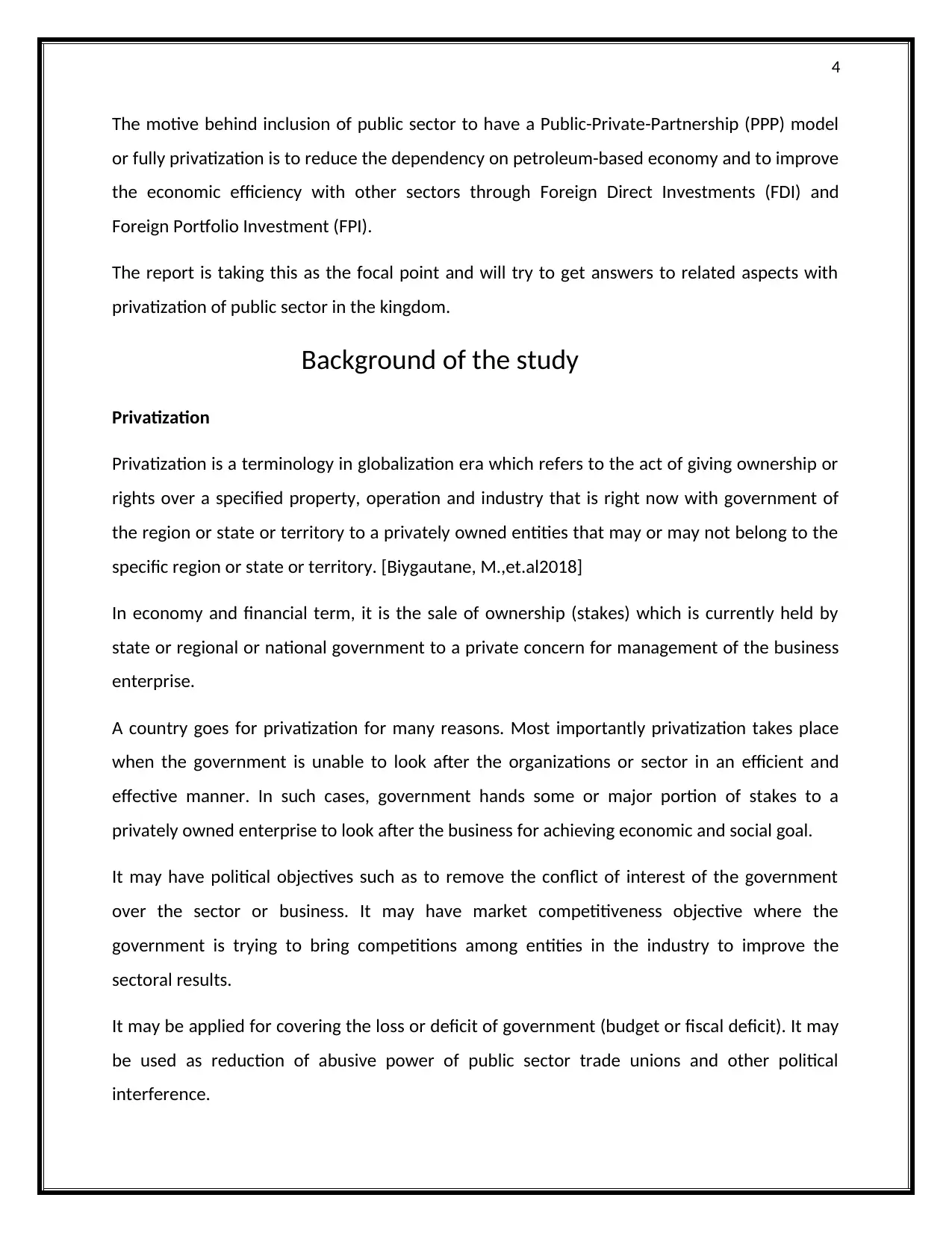
4
The motive behind inclusion of public sector to have a Public-Private-Partnership (PPP) model
or fully privatization is to reduce the dependency on petroleum-based economy and to improve
the economic efficiency with other sectors through Foreign Direct Investments (FDI) and
Foreign Portfolio Investment (FPI).
The report is taking this as the focal point and will try to get answers to related aspects with
privatization of public sector in the kingdom.
Background of the study
Privatization
Privatization is a terminology in globalization era which refers to the act of giving ownership or
rights over a specified property, operation and industry that is right now with government of
the region or state or territory to a privately owned entities that may or may not belong to the
specific region or state or territory. [Biygautane, M.,et.al2018]
In economy and financial term, it is the sale of ownership (stakes) which is currently held by
state or regional or national government to a private concern for management of the business
enterprise.
A country goes for privatization for many reasons. Most importantly privatization takes place
when the government is unable to look after the organizations or sector in an efficient and
effective manner. In such cases, government hands some or major portion of stakes to a
privately owned enterprise to look after the business for achieving economic and social goal.
It may have political objectives such as to remove the conflict of interest of the government
over the sector or business. It may have market competitiveness objective where the
government is trying to bring competitions among entities in the industry to improve the
sectoral results.
It may be applied for covering the loss or deficit of government (budget or fiscal deficit). It may
be used as reduction of abusive power of public sector trade unions and other political
interference.
The motive behind inclusion of public sector to have a Public-Private-Partnership (PPP) model
or fully privatization is to reduce the dependency on petroleum-based economy and to improve
the economic efficiency with other sectors through Foreign Direct Investments (FDI) and
Foreign Portfolio Investment (FPI).
The report is taking this as the focal point and will try to get answers to related aspects with
privatization of public sector in the kingdom.
Background of the study
Privatization
Privatization is a terminology in globalization era which refers to the act of giving ownership or
rights over a specified property, operation and industry that is right now with government of
the region or state or territory to a privately owned entities that may or may not belong to the
specific region or state or territory. [Biygautane, M.,et.al2018]
In economy and financial term, it is the sale of ownership (stakes) which is currently held by
state or regional or national government to a private concern for management of the business
enterprise.
A country goes for privatization for many reasons. Most importantly privatization takes place
when the government is unable to look after the organizations or sector in an efficient and
effective manner. In such cases, government hands some or major portion of stakes to a
privately owned enterprise to look after the business for achieving economic and social goal.
It may have political objectives such as to remove the conflict of interest of the government
over the sector or business. It may have market competitiveness objective where the
government is trying to bring competitions among entities in the industry to improve the
sectoral results.
It may be applied for covering the loss or deficit of government (budget or fiscal deficit). It may
be used as reduction of abusive power of public sector trade unions and other political
interference.
Paraphrase This Document
Need a fresh take? Get an instant paraphrase of this document with our AI Paraphraser
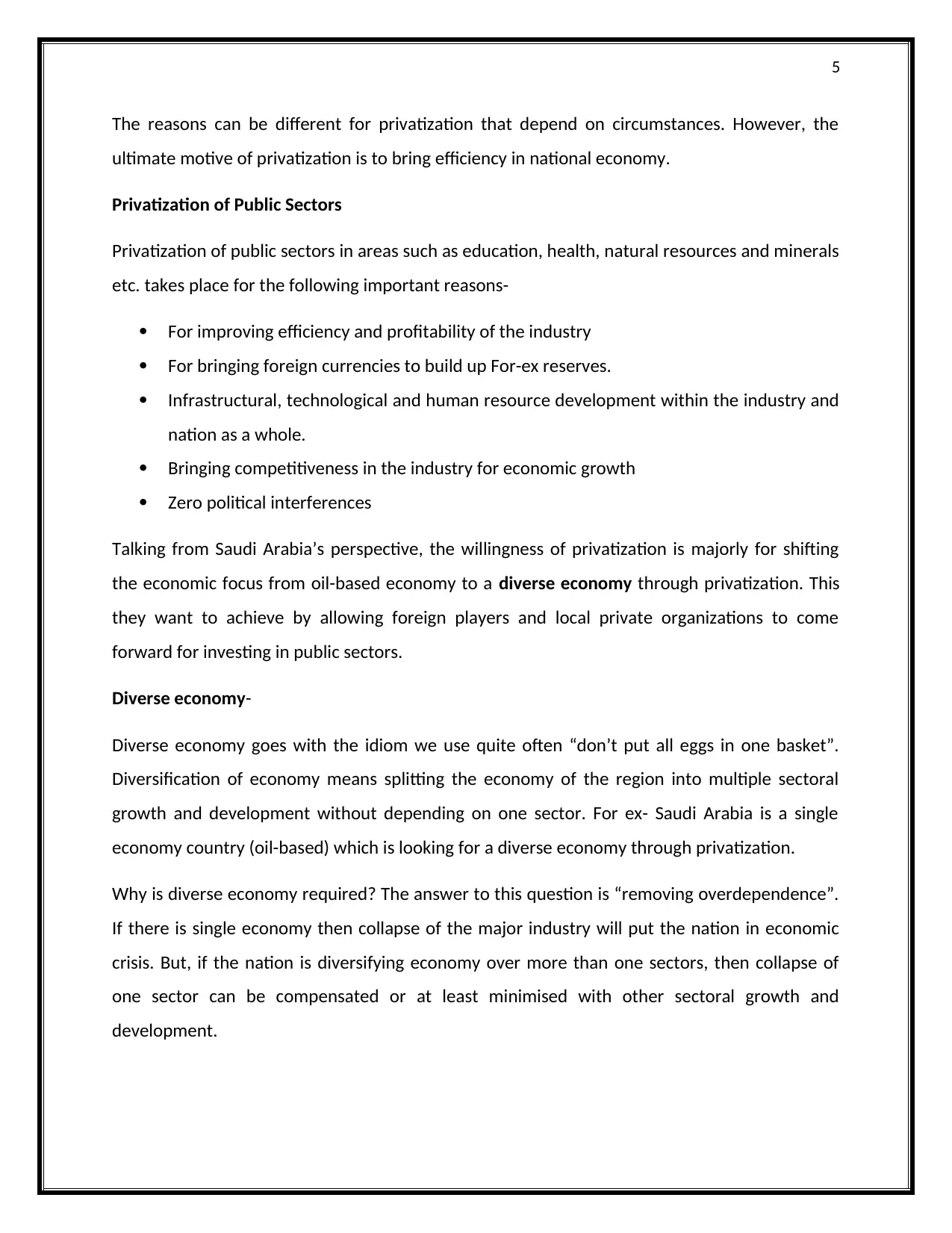
5
The reasons can be different for privatization that depend on circumstances. However, the
ultimate motive of privatization is to bring efficiency in national economy.
Privatization of Public Sectors
Privatization of public sectors in areas such as education, health, natural resources and minerals
etc. takes place for the following important reasons-
For improving efficiency and profitability of the industry
For bringing foreign currencies to build up For-ex reserves.
Infrastructural, technological and human resource development within the industry and
nation as a whole.
Bringing competitiveness in the industry for economic growth
Zero political interferences
Talking from Saudi Arabia’s perspective, the willingness of privatization is majorly for shifting
the economic focus from oil-based economy to a diverse economy through privatization. This
they want to achieve by allowing foreign players and local private organizations to come
forward for investing in public sectors.
Diverse economy-
Diverse economy goes with the idiom we use quite often “don’t put all eggs in one basket”.
Diversification of economy means splitting the economy of the region into multiple sectoral
growth and development without depending on one sector. For ex- Saudi Arabia is a single
economy country (oil-based) which is looking for a diverse economy through privatization.
Why is diverse economy required? The answer to this question is “removing overdependence”.
If there is single economy then collapse of the major industry will put the nation in economic
crisis. But, if the nation is diversifying economy over more than one sectors, then collapse of
one sector can be compensated or at least minimised with other sectoral growth and
development.
The reasons can be different for privatization that depend on circumstances. However, the
ultimate motive of privatization is to bring efficiency in national economy.
Privatization of Public Sectors
Privatization of public sectors in areas such as education, health, natural resources and minerals
etc. takes place for the following important reasons-
For improving efficiency and profitability of the industry
For bringing foreign currencies to build up For-ex reserves.
Infrastructural, technological and human resource development within the industry and
nation as a whole.
Bringing competitiveness in the industry for economic growth
Zero political interferences
Talking from Saudi Arabia’s perspective, the willingness of privatization is majorly for shifting
the economic focus from oil-based economy to a diverse economy through privatization. This
they want to achieve by allowing foreign players and local private organizations to come
forward for investing in public sectors.
Diverse economy-
Diverse economy goes with the idiom we use quite often “don’t put all eggs in one basket”.
Diversification of economy means splitting the economy of the region into multiple sectoral
growth and development without depending on one sector. For ex- Saudi Arabia is a single
economy country (oil-based) which is looking for a diverse economy through privatization.
Why is diverse economy required? The answer to this question is “removing overdependence”.
If there is single economy then collapse of the major industry will put the nation in economic
crisis. But, if the nation is diversifying economy over more than one sectors, then collapse of
one sector can be compensated or at least minimised with other sectoral growth and
development.
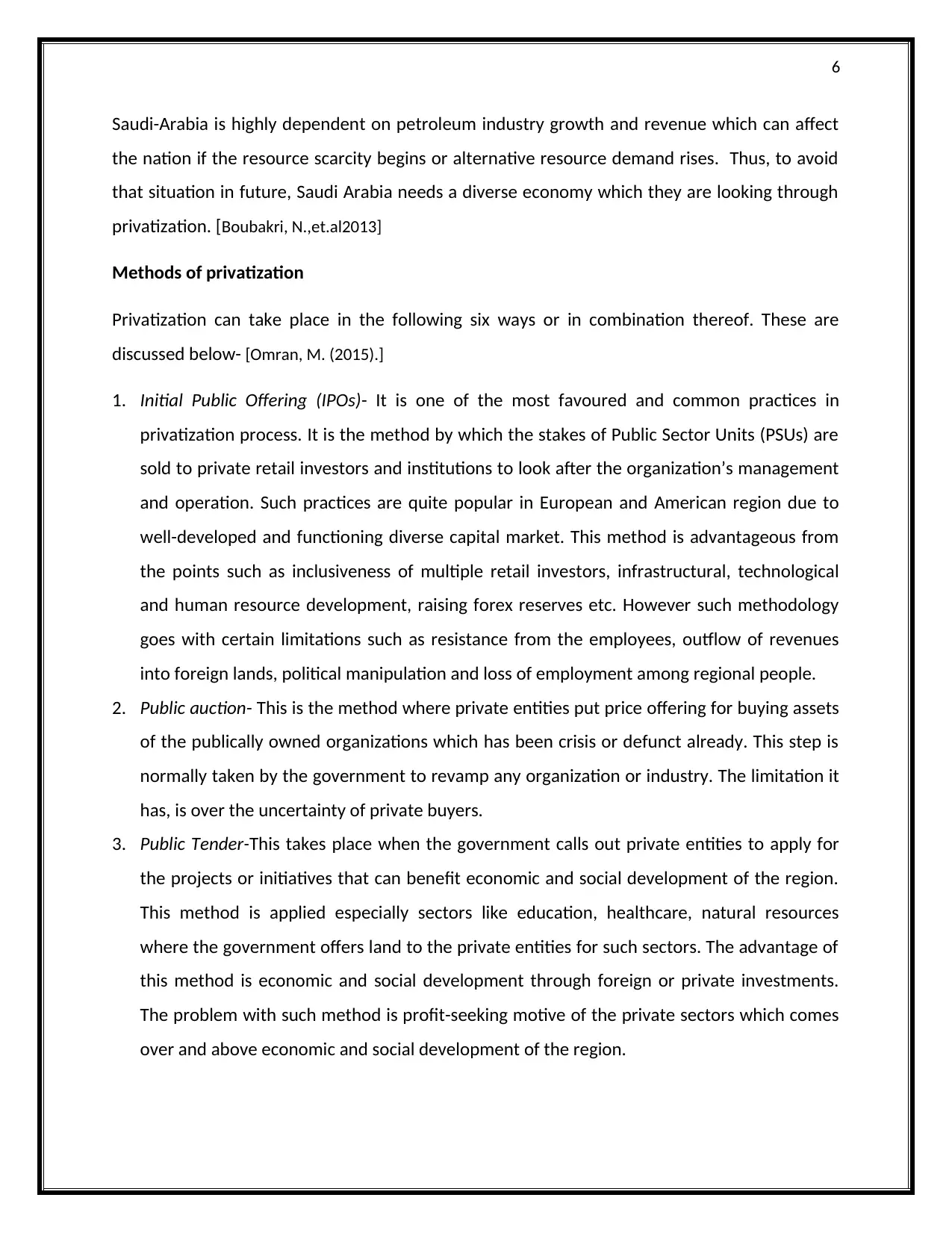
6
Saudi-Arabia is highly dependent on petroleum industry growth and revenue which can affect
the nation if the resource scarcity begins or alternative resource demand rises. Thus, to avoid
that situation in future, Saudi Arabia needs a diverse economy which they are looking through
privatization. [Boubakri, N.,et.al2013]
Methods of privatization
Privatization can take place in the following six ways or in combination thereof. These are
discussed below- [Omran, M. (2015).]
1. Initial Public Offering (IPOs)- It is one of the most favoured and common practices in
privatization process. It is the method by which the stakes of Public Sector Units (PSUs) are
sold to private retail investors and institutions to look after the organization’s management
and operation. Such practices are quite popular in European and American region due to
well-developed and functioning diverse capital market. This method is advantageous from
the points such as inclusiveness of multiple retail investors, infrastructural, technological
and human resource development, raising forex reserves etc. However such methodology
goes with certain limitations such as resistance from the employees, outflow of revenues
into foreign lands, political manipulation and loss of employment among regional people.
2. Public auction- This is the method where private entities put price offering for buying assets
of the publically owned organizations which has been crisis or defunct already. This step is
normally taken by the government to revamp any organization or industry. The limitation it
has, is over the uncertainty of private buyers.
3. Public Tender-This takes place when the government calls out private entities to apply for
the projects or initiatives that can benefit economic and social development of the region.
This method is applied especially sectors like education, healthcare, natural resources
where the government offers land to the private entities for such sectors. The advantage of
this method is economic and social development through foreign or private investments.
The problem with such method is profit-seeking motive of the private sectors which comes
over and above economic and social development of the region.
Saudi-Arabia is highly dependent on petroleum industry growth and revenue which can affect
the nation if the resource scarcity begins or alternative resource demand rises. Thus, to avoid
that situation in future, Saudi Arabia needs a diverse economy which they are looking through
privatization. [Boubakri, N.,et.al2013]
Methods of privatization
Privatization can take place in the following six ways or in combination thereof. These are
discussed below- [Omran, M. (2015).]
1. Initial Public Offering (IPOs)- It is one of the most favoured and common practices in
privatization process. It is the method by which the stakes of Public Sector Units (PSUs) are
sold to private retail investors and institutions to look after the organization’s management
and operation. Such practices are quite popular in European and American region due to
well-developed and functioning diverse capital market. This method is advantageous from
the points such as inclusiveness of multiple retail investors, infrastructural, technological
and human resource development, raising forex reserves etc. However such methodology
goes with certain limitations such as resistance from the employees, outflow of revenues
into foreign lands, political manipulation and loss of employment among regional people.
2. Public auction- This is the method where private entities put price offering for buying assets
of the publically owned organizations which has been crisis or defunct already. This step is
normally taken by the government to revamp any organization or industry. The limitation it
has, is over the uncertainty of private buyers.
3. Public Tender-This takes place when the government calls out private entities to apply for
the projects or initiatives that can benefit economic and social development of the region.
This method is applied especially sectors like education, healthcare, natural resources
where the government offers land to the private entities for such sectors. The advantage of
this method is economic and social development through foreign or private investments.
The problem with such method is profit-seeking motive of the private sectors which comes
over and above economic and social development of the region.
⊘ This is a preview!⊘
Do you want full access?
Subscribe today to unlock all pages.

Trusted by 1+ million students worldwide
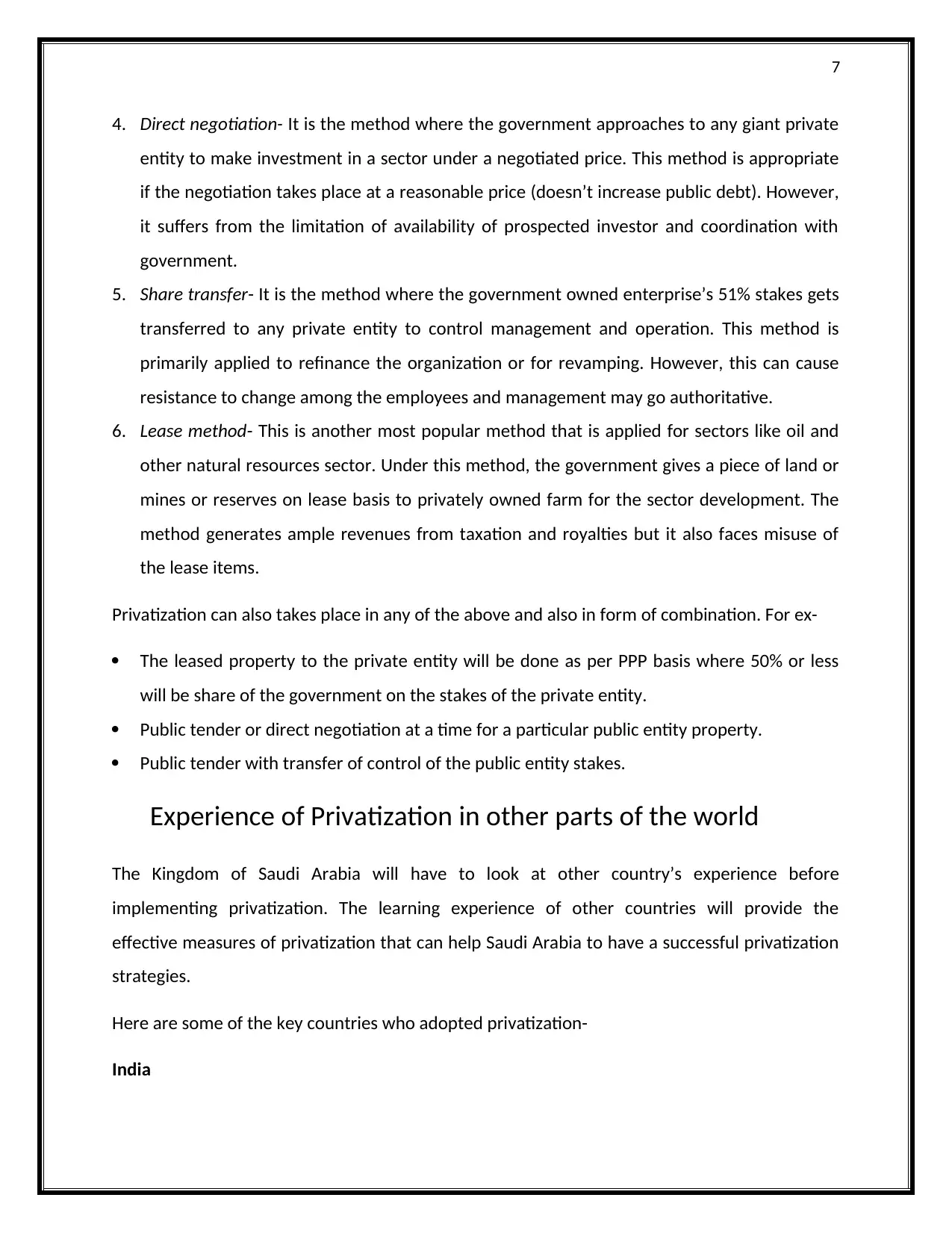
7
4. Direct negotiation- It is the method where the government approaches to any giant private
entity to make investment in a sector under a negotiated price. This method is appropriate
if the negotiation takes place at a reasonable price (doesn’t increase public debt). However,
it suffers from the limitation of availability of prospected investor and coordination with
government.
5. Share transfer- It is the method where the government owned enterprise’s 51% stakes gets
transferred to any private entity to control management and operation. This method is
primarily applied to refinance the organization or for revamping. However, this can cause
resistance to change among the employees and management may go authoritative.
6. Lease method- This is another most popular method that is applied for sectors like oil and
other natural resources sector. Under this method, the government gives a piece of land or
mines or reserves on lease basis to privately owned farm for the sector development. The
method generates ample revenues from taxation and royalties but it also faces misuse of
the lease items.
Privatization can also takes place in any of the above and also in form of combination. For ex-
The leased property to the private entity will be done as per PPP basis where 50% or less
will be share of the government on the stakes of the private entity.
Public tender or direct negotiation at a time for a particular public entity property.
Public tender with transfer of control of the public entity stakes.
Experience of Privatization in other parts of the world
The Kingdom of Saudi Arabia will have to look at other country’s experience before
implementing privatization. The learning experience of other countries will provide the
effective measures of privatization that can help Saudi Arabia to have a successful privatization
strategies.
Here are some of the key countries who adopted privatization-
India
4. Direct negotiation- It is the method where the government approaches to any giant private
entity to make investment in a sector under a negotiated price. This method is appropriate
if the negotiation takes place at a reasonable price (doesn’t increase public debt). However,
it suffers from the limitation of availability of prospected investor and coordination with
government.
5. Share transfer- It is the method where the government owned enterprise’s 51% stakes gets
transferred to any private entity to control management and operation. This method is
primarily applied to refinance the organization or for revamping. However, this can cause
resistance to change among the employees and management may go authoritative.
6. Lease method- This is another most popular method that is applied for sectors like oil and
other natural resources sector. Under this method, the government gives a piece of land or
mines or reserves on lease basis to privately owned farm for the sector development. The
method generates ample revenues from taxation and royalties but it also faces misuse of
the lease items.
Privatization can also takes place in any of the above and also in form of combination. For ex-
The leased property to the private entity will be done as per PPP basis where 50% or less
will be share of the government on the stakes of the private entity.
Public tender or direct negotiation at a time for a particular public entity property.
Public tender with transfer of control of the public entity stakes.
Experience of Privatization in other parts of the world
The Kingdom of Saudi Arabia will have to look at other country’s experience before
implementing privatization. The learning experience of other countries will provide the
effective measures of privatization that can help Saudi Arabia to have a successful privatization
strategies.
Here are some of the key countries who adopted privatization-
India
Paraphrase This Document
Need a fresh take? Get an instant paraphrase of this document with our AI Paraphraser
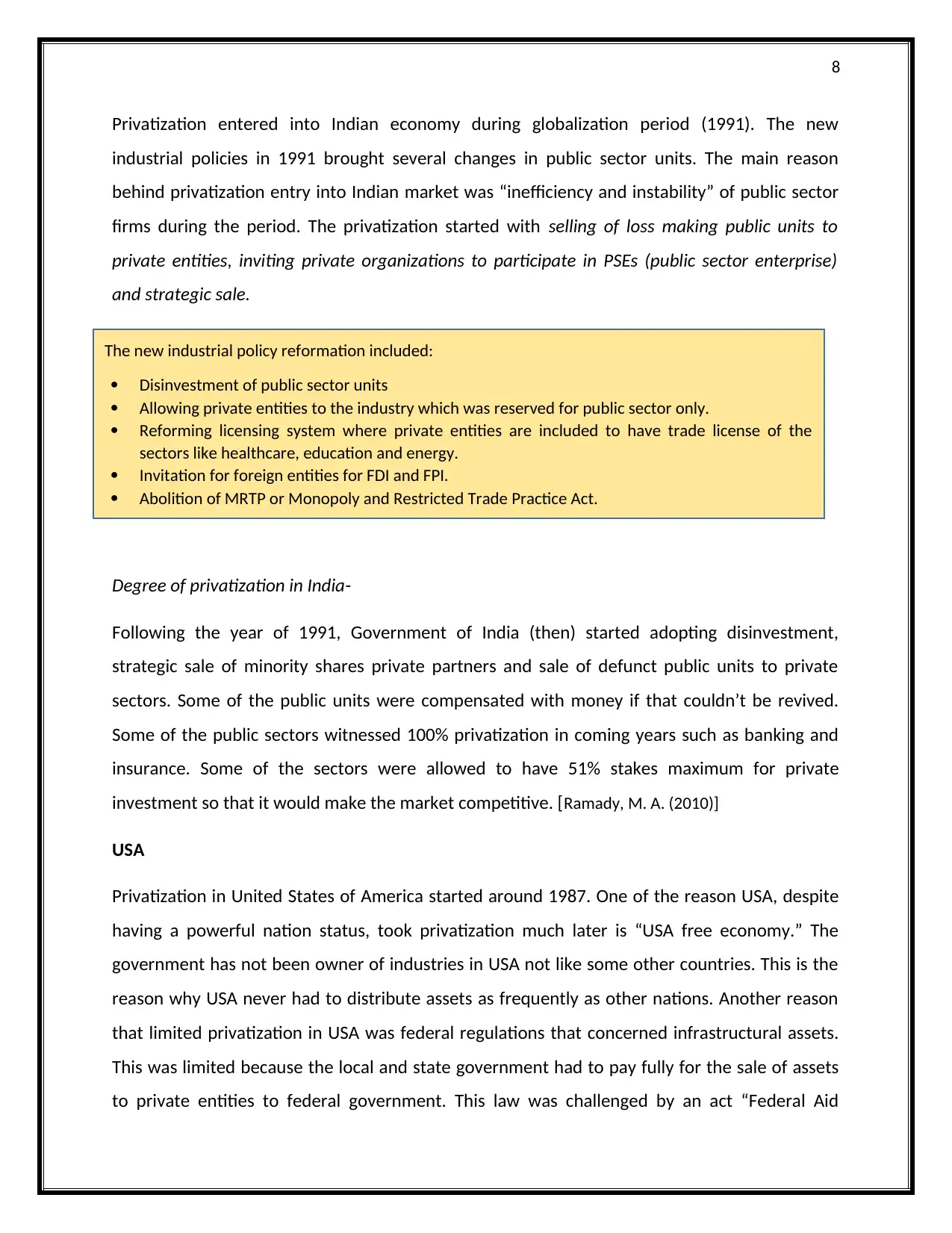
8
Privatization entered into Indian economy during globalization period (1991). The new
industrial policies in 1991 brought several changes in public sector units. The main reason
behind privatization entry into Indian market was “inefficiency and instability” of public sector
firms during the period. The privatization started with selling of loss making public units to
private entities, inviting private organizations to participate in PSEs (public sector enterprise)
and strategic sale.
Degree of privatization in India-
Following the year of 1991, Government of India (then) started adopting disinvestment,
strategic sale of minority shares private partners and sale of defunct public units to private
sectors. Some of the public units were compensated with money if that couldn’t be revived.
Some of the public sectors witnessed 100% privatization in coming years such as banking and
insurance. Some of the sectors were allowed to have 51% stakes maximum for private
investment so that it would make the market competitive. [Ramady, M. A. (2010)]
USA
Privatization in United States of America started around 1987. One of the reason USA, despite
having a powerful nation status, took privatization much later is “USA free economy.” The
government has not been owner of industries in USA not like some other countries. This is the
reason why USA never had to distribute assets as frequently as other nations. Another reason
that limited privatization in USA was federal regulations that concerned infrastructural assets.
This was limited because the local and state government had to pay fully for the sale of assets
to private entities to federal government. This law was challenged by an act “Federal Aid
The new industrial policy reformation included:
Disinvestment of public sector units
Allowing private entities to the industry which was reserved for public sector only.
Reforming licensing system where private entities are included to have trade license of the
sectors like healthcare, education and energy.
Invitation for foreign entities for FDI and FPI.
Abolition of MRTP or Monopoly and Restricted Trade Practice Act.
Privatization entered into Indian economy during globalization period (1991). The new
industrial policies in 1991 brought several changes in public sector units. The main reason
behind privatization entry into Indian market was “inefficiency and instability” of public sector
firms during the period. The privatization started with selling of loss making public units to
private entities, inviting private organizations to participate in PSEs (public sector enterprise)
and strategic sale.
Degree of privatization in India-
Following the year of 1991, Government of India (then) started adopting disinvestment,
strategic sale of minority shares private partners and sale of defunct public units to private
sectors. Some of the public units were compensated with money if that couldn’t be revived.
Some of the public sectors witnessed 100% privatization in coming years such as banking and
insurance. Some of the sectors were allowed to have 51% stakes maximum for private
investment so that it would make the market competitive. [Ramady, M. A. (2010)]
USA
Privatization in United States of America started around 1987. One of the reason USA, despite
having a powerful nation status, took privatization much later is “USA free economy.” The
government has not been owner of industries in USA not like some other countries. This is the
reason why USA never had to distribute assets as frequently as other nations. Another reason
that limited privatization in USA was federal regulations that concerned infrastructural assets.
This was limited because the local and state government had to pay fully for the sale of assets
to private entities to federal government. This law was challenged by an act “Federal Aid
The new industrial policy reformation included:
Disinvestment of public sector units
Allowing private entities to the industry which was reserved for public sector only.
Reforming licensing system where private entities are included to have trade license of the
sectors like healthcare, education and energy.
Invitation for foreign entities for FDI and FPI.
Abolition of MRTP or Monopoly and Restricted Trade Practice Act.
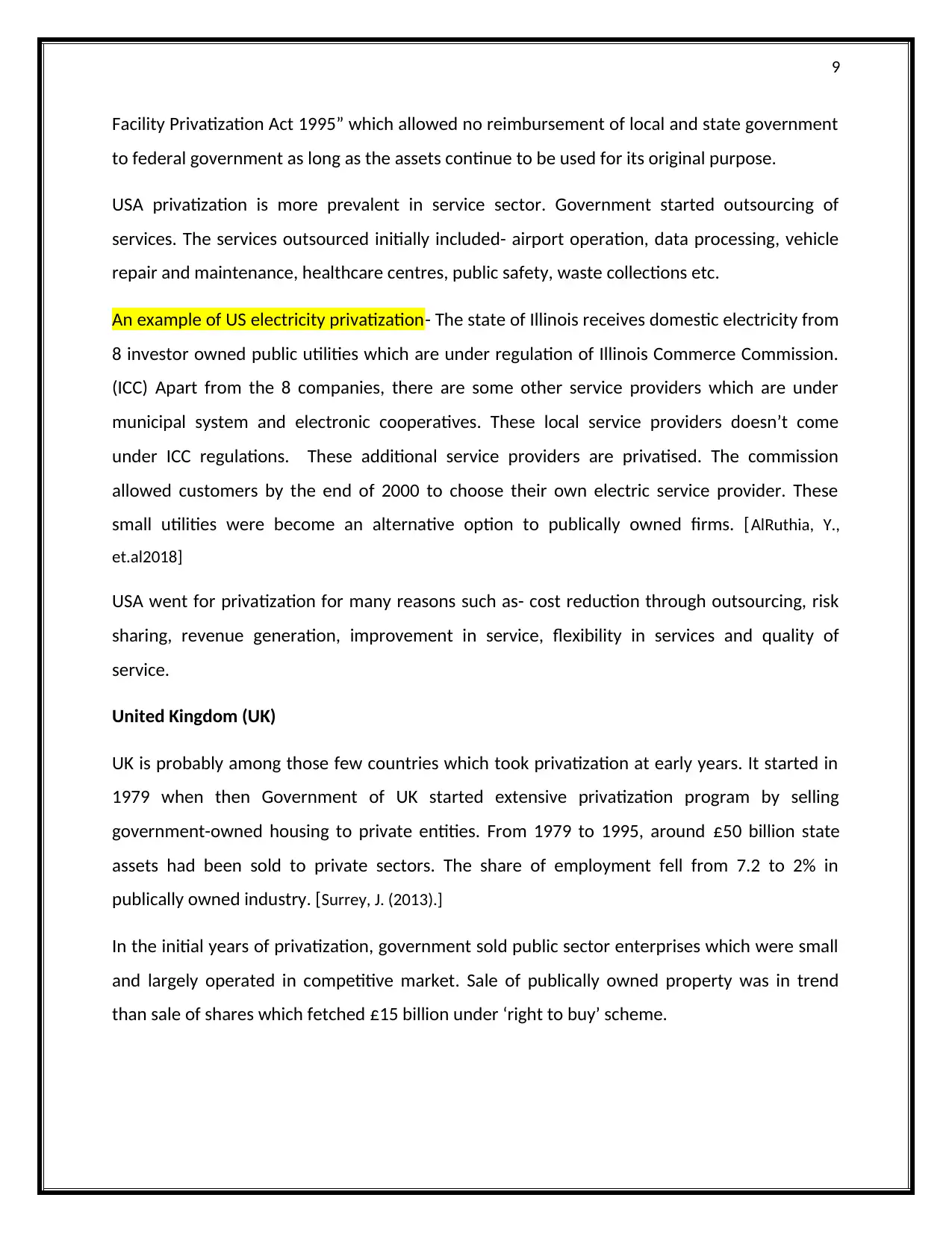
9
Facility Privatization Act 1995” which allowed no reimbursement of local and state government
to federal government as long as the assets continue to be used for its original purpose.
USA privatization is more prevalent in service sector. Government started outsourcing of
services. The services outsourced initially included- airport operation, data processing, vehicle
repair and maintenance, healthcare centres, public safety, waste collections etc.
An example of US electricity privatization- The state of Illinois receives domestic electricity from
8 investor owned public utilities which are under regulation of Illinois Commerce Commission.
(ICC) Apart from the 8 companies, there are some other service providers which are under
municipal system and electronic cooperatives. These local service providers doesn’t come
under ICC regulations. These additional service providers are privatised. The commission
allowed customers by the end of 2000 to choose their own electric service provider. These
small utilities were become an alternative option to publically owned firms. [AlRuthia, Y.,
et.al2018]
USA went for privatization for many reasons such as- cost reduction through outsourcing, risk
sharing, revenue generation, improvement in service, flexibility in services and quality of
service.
United Kingdom (UK)
UK is probably among those few countries which took privatization at early years. It started in
1979 when then Government of UK started extensive privatization program by selling
government-owned housing to private entities. From 1979 to 1995, around £50 billion state
assets had been sold to private sectors. The share of employment fell from 7.2 to 2% in
publically owned industry. [Surrey, J. (2013).]
In the initial years of privatization, government sold public sector enterprises which were small
and largely operated in competitive market. Sale of publically owned property was in trend
than sale of shares which fetched £15 billion under ‘right to buy’ scheme.
Facility Privatization Act 1995” which allowed no reimbursement of local and state government
to federal government as long as the assets continue to be used for its original purpose.
USA privatization is more prevalent in service sector. Government started outsourcing of
services. The services outsourced initially included- airport operation, data processing, vehicle
repair and maintenance, healthcare centres, public safety, waste collections etc.
An example of US electricity privatization- The state of Illinois receives domestic electricity from
8 investor owned public utilities which are under regulation of Illinois Commerce Commission.
(ICC) Apart from the 8 companies, there are some other service providers which are under
municipal system and electronic cooperatives. These local service providers doesn’t come
under ICC regulations. These additional service providers are privatised. The commission
allowed customers by the end of 2000 to choose their own electric service provider. These
small utilities were become an alternative option to publically owned firms. [AlRuthia, Y.,
et.al2018]
USA went for privatization for many reasons such as- cost reduction through outsourcing, risk
sharing, revenue generation, improvement in service, flexibility in services and quality of
service.
United Kingdom (UK)
UK is probably among those few countries which took privatization at early years. It started in
1979 when then Government of UK started extensive privatization program by selling
government-owned housing to private entities. From 1979 to 1995, around £50 billion state
assets had been sold to private sectors. The share of employment fell from 7.2 to 2% in
publically owned industry. [Surrey, J. (2013).]
In the initial years of privatization, government sold public sector enterprises which were small
and largely operated in competitive market. Sale of publically owned property was in trend
than sale of shares which fetched £15 billion under ‘right to buy’ scheme.
⊘ This is a preview!⊘
Do you want full access?
Subscribe today to unlock all pages.

Trusted by 1+ million students worldwide
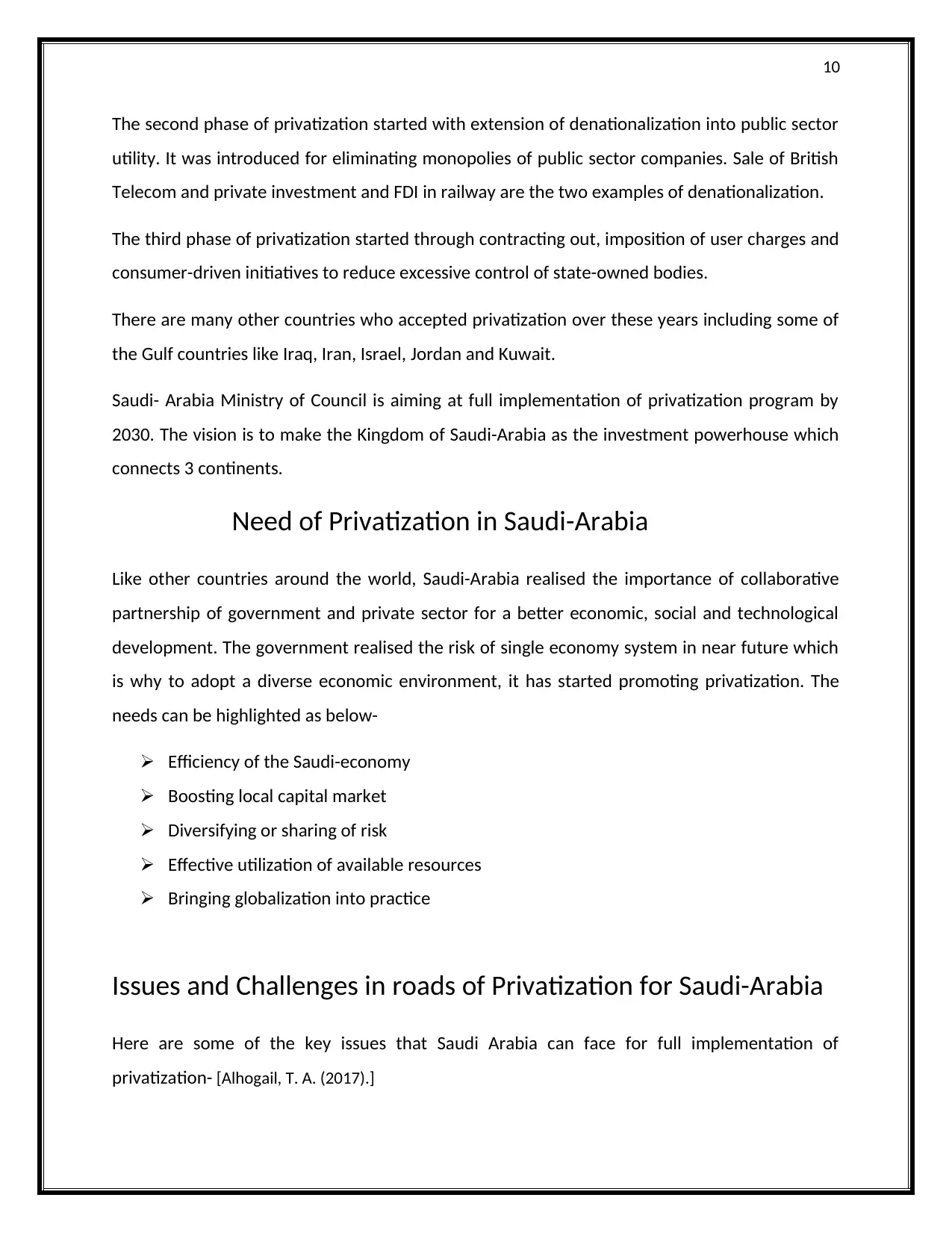
10
The second phase of privatization started with extension of denationalization into public sector
utility. It was introduced for eliminating monopolies of public sector companies. Sale of British
Telecom and private investment and FDI in railway are the two examples of denationalization.
The third phase of privatization started through contracting out, imposition of user charges and
consumer-driven initiatives to reduce excessive control of state-owned bodies.
There are many other countries who accepted privatization over these years including some of
the Gulf countries like Iraq, Iran, Israel, Jordan and Kuwait.
Saudi- Arabia Ministry of Council is aiming at full implementation of privatization program by
2030. The vision is to make the Kingdom of Saudi-Arabia as the investment powerhouse which
connects 3 continents.
Need of Privatization in Saudi-Arabia
Like other countries around the world, Saudi-Arabia realised the importance of collaborative
partnership of government and private sector for a better economic, social and technological
development. The government realised the risk of single economy system in near future which
is why to adopt a diverse economic environment, it has started promoting privatization. The
needs can be highlighted as below-
Efficiency of the Saudi-economy
Boosting local capital market
Diversifying or sharing of risk
Effective utilization of available resources
Bringing globalization into practice
Issues and Challenges in roads of Privatization for Saudi-Arabia
Here are some of the key issues that Saudi Arabia can face for full implementation of
privatization- [Alhogail, T. A. (2017).]
The second phase of privatization started with extension of denationalization into public sector
utility. It was introduced for eliminating monopolies of public sector companies. Sale of British
Telecom and private investment and FDI in railway are the two examples of denationalization.
The third phase of privatization started through contracting out, imposition of user charges and
consumer-driven initiatives to reduce excessive control of state-owned bodies.
There are many other countries who accepted privatization over these years including some of
the Gulf countries like Iraq, Iran, Israel, Jordan and Kuwait.
Saudi- Arabia Ministry of Council is aiming at full implementation of privatization program by
2030. The vision is to make the Kingdom of Saudi-Arabia as the investment powerhouse which
connects 3 continents.
Need of Privatization in Saudi-Arabia
Like other countries around the world, Saudi-Arabia realised the importance of collaborative
partnership of government and private sector for a better economic, social and technological
development. The government realised the risk of single economy system in near future which
is why to adopt a diverse economic environment, it has started promoting privatization. The
needs can be highlighted as below-
Efficiency of the Saudi-economy
Boosting local capital market
Diversifying or sharing of risk
Effective utilization of available resources
Bringing globalization into practice
Issues and Challenges in roads of Privatization for Saudi-Arabia
Here are some of the key issues that Saudi Arabia can face for full implementation of
privatization- [Alhogail, T. A. (2017).]
Paraphrase This Document
Need a fresh take? Get an instant paraphrase of this document with our AI Paraphraser
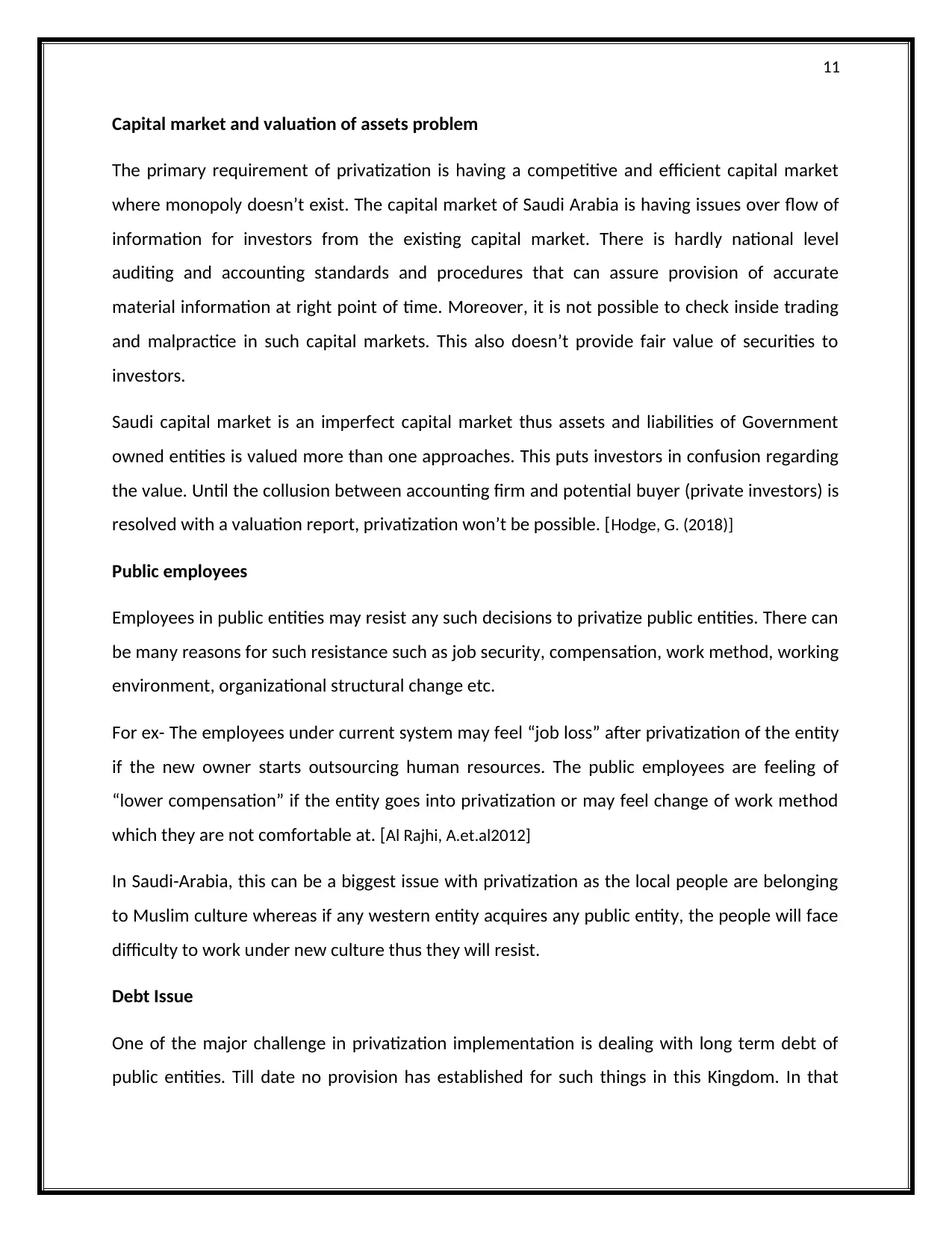
11
Capital market and valuation of assets problem
The primary requirement of privatization is having a competitive and efficient capital market
where monopoly doesn’t exist. The capital market of Saudi Arabia is having issues over flow of
information for investors from the existing capital market. There is hardly national level
auditing and accounting standards and procedures that can assure provision of accurate
material information at right point of time. Moreover, it is not possible to check inside trading
and malpractice in such capital markets. This also doesn’t provide fair value of securities to
investors.
Saudi capital market is an imperfect capital market thus assets and liabilities of Government
owned entities is valued more than one approaches. This puts investors in confusion regarding
the value. Until the collusion between accounting firm and potential buyer (private investors) is
resolved with a valuation report, privatization won’t be possible. [Hodge, G. (2018)]
Public employees
Employees in public entities may resist any such decisions to privatize public entities. There can
be many reasons for such resistance such as job security, compensation, work method, working
environment, organizational structural change etc.
For ex- The employees under current system may feel “job loss” after privatization of the entity
if the new owner starts outsourcing human resources. The public employees are feeling of
“lower compensation” if the entity goes into privatization or may feel change of work method
which they are not comfortable at. [Al Rajhi, A.et.al2012]
In Saudi-Arabia, this can be a biggest issue with privatization as the local people are belonging
to Muslim culture whereas if any western entity acquires any public entity, the people will face
difficulty to work under new culture thus they will resist.
Debt Issue
One of the major challenge in privatization implementation is dealing with long term debt of
public entities. Till date no provision has established for such things in this Kingdom. In that
Capital market and valuation of assets problem
The primary requirement of privatization is having a competitive and efficient capital market
where monopoly doesn’t exist. The capital market of Saudi Arabia is having issues over flow of
information for investors from the existing capital market. There is hardly national level
auditing and accounting standards and procedures that can assure provision of accurate
material information at right point of time. Moreover, it is not possible to check inside trading
and malpractice in such capital markets. This also doesn’t provide fair value of securities to
investors.
Saudi capital market is an imperfect capital market thus assets and liabilities of Government
owned entities is valued more than one approaches. This puts investors in confusion regarding
the value. Until the collusion between accounting firm and potential buyer (private investors) is
resolved with a valuation report, privatization won’t be possible. [Hodge, G. (2018)]
Public employees
Employees in public entities may resist any such decisions to privatize public entities. There can
be many reasons for such resistance such as job security, compensation, work method, working
environment, organizational structural change etc.
For ex- The employees under current system may feel “job loss” after privatization of the entity
if the new owner starts outsourcing human resources. The public employees are feeling of
“lower compensation” if the entity goes into privatization or may feel change of work method
which they are not comfortable at. [Al Rajhi, A.et.al2012]
In Saudi-Arabia, this can be a biggest issue with privatization as the local people are belonging
to Muslim culture whereas if any western entity acquires any public entity, the people will face
difficulty to work under new culture thus they will resist.
Debt Issue
One of the major challenge in privatization implementation is dealing with long term debt of
public entities. Till date no provision has established for such things in this Kingdom. In that
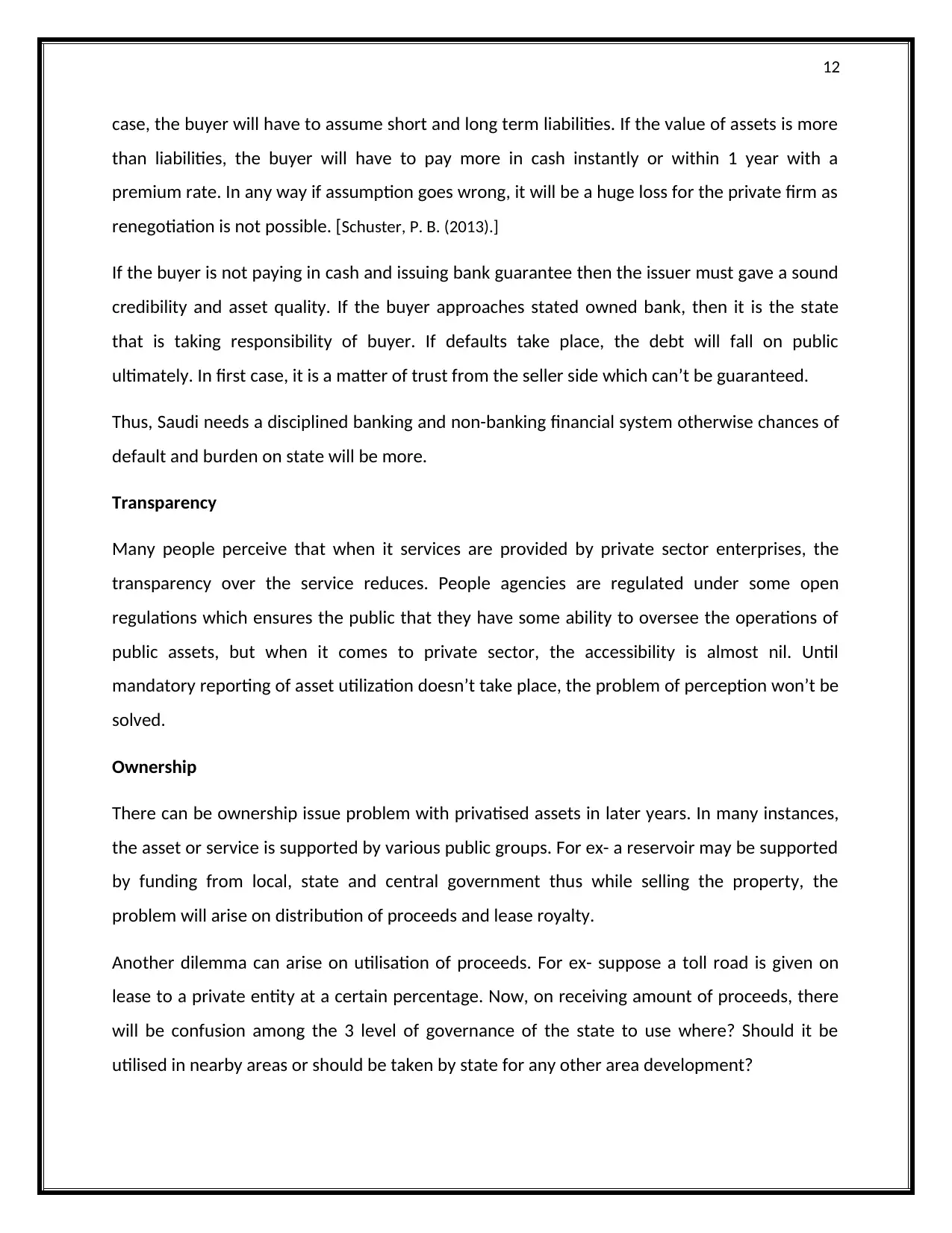
12
case, the buyer will have to assume short and long term liabilities. If the value of assets is more
than liabilities, the buyer will have to pay more in cash instantly or within 1 year with a
premium rate. In any way if assumption goes wrong, it will be a huge loss for the private firm as
renegotiation is not possible. [Schuster, P. B. (2013).]
If the buyer is not paying in cash and issuing bank guarantee then the issuer must gave a sound
credibility and asset quality. If the buyer approaches stated owned bank, then it is the state
that is taking responsibility of buyer. If defaults take place, the debt will fall on public
ultimately. In first case, it is a matter of trust from the seller side which can’t be guaranteed.
Thus, Saudi needs a disciplined banking and non-banking financial system otherwise chances of
default and burden on state will be more.
Transparency
Many people perceive that when it services are provided by private sector enterprises, the
transparency over the service reduces. People agencies are regulated under some open
regulations which ensures the public that they have some ability to oversee the operations of
public assets, but when it comes to private sector, the accessibility is almost nil. Until
mandatory reporting of asset utilization doesn’t take place, the problem of perception won’t be
solved.
Ownership
There can be ownership issue problem with privatised assets in later years. In many instances,
the asset or service is supported by various public groups. For ex- a reservoir may be supported
by funding from local, state and central government thus while selling the property, the
problem will arise on distribution of proceeds and lease royalty.
Another dilemma can arise on utilisation of proceeds. For ex- suppose a toll road is given on
lease to a private entity at a certain percentage. Now, on receiving amount of proceeds, there
will be confusion among the 3 level of governance of the state to use where? Should it be
utilised in nearby areas or should be taken by state for any other area development?
case, the buyer will have to assume short and long term liabilities. If the value of assets is more
than liabilities, the buyer will have to pay more in cash instantly or within 1 year with a
premium rate. In any way if assumption goes wrong, it will be a huge loss for the private firm as
renegotiation is not possible. [Schuster, P. B. (2013).]
If the buyer is not paying in cash and issuing bank guarantee then the issuer must gave a sound
credibility and asset quality. If the buyer approaches stated owned bank, then it is the state
that is taking responsibility of buyer. If defaults take place, the debt will fall on public
ultimately. In first case, it is a matter of trust from the seller side which can’t be guaranteed.
Thus, Saudi needs a disciplined banking and non-banking financial system otherwise chances of
default and burden on state will be more.
Transparency
Many people perceive that when it services are provided by private sector enterprises, the
transparency over the service reduces. People agencies are regulated under some open
regulations which ensures the public that they have some ability to oversee the operations of
public assets, but when it comes to private sector, the accessibility is almost nil. Until
mandatory reporting of asset utilization doesn’t take place, the problem of perception won’t be
solved.
Ownership
There can be ownership issue problem with privatised assets in later years. In many instances,
the asset or service is supported by various public groups. For ex- a reservoir may be supported
by funding from local, state and central government thus while selling the property, the
problem will arise on distribution of proceeds and lease royalty.
Another dilemma can arise on utilisation of proceeds. For ex- suppose a toll road is given on
lease to a private entity at a certain percentage. Now, on receiving amount of proceeds, there
will be confusion among the 3 level of governance of the state to use where? Should it be
utilised in nearby areas or should be taken by state for any other area development?
⊘ This is a preview!⊘
Do you want full access?
Subscribe today to unlock all pages.

Trusted by 1+ million students worldwide
1 out of 22
Related Documents
Your All-in-One AI-Powered Toolkit for Academic Success.
+13062052269
info@desklib.com
Available 24*7 on WhatsApp / Email
![[object Object]](/_next/static/media/star-bottom.7253800d.svg)
Unlock your academic potential
Copyright © 2020–2025 A2Z Services. All Rights Reserved. Developed and managed by ZUCOL.





